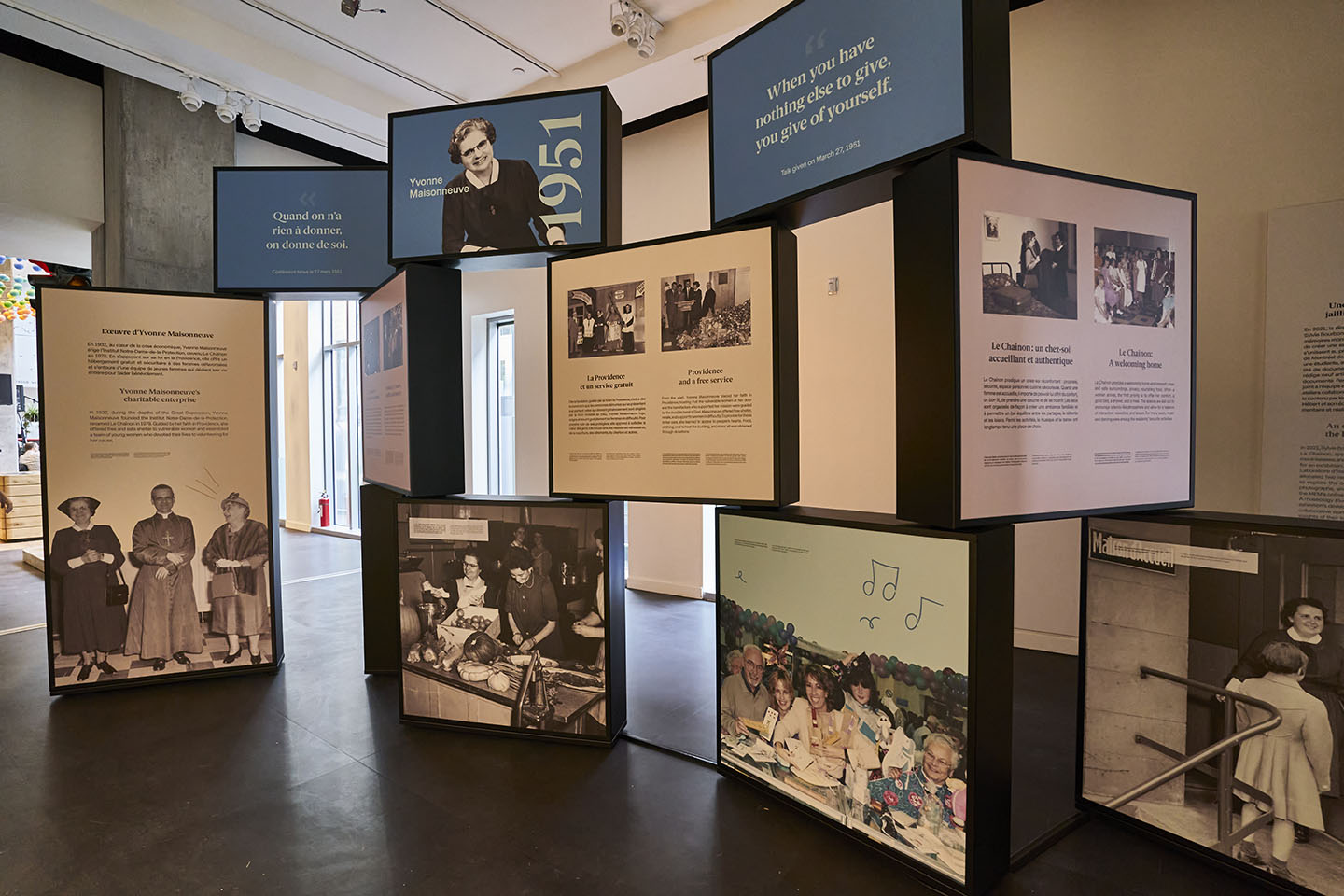
Event description
The exhibitions presented in theMEM’s Kiosque are develop by different groups, communities and individuals, with the support of the museum team. The Kiosque gives new life to existing projects. Organizations and individuals share their history, memories and experiences—in their voices. Each exhibition takes a unique form, thanks to modules that can be assembled in a variety of ways. The Kiosque is located in the MEM’s public spaces.
Who can present a project?
Are you a community organization or non-profit, a collective, an association or a volunteer group? Have you already developd a project that has been presented in a virtual or physical space? You can submit your project using the form. You have until March 15, 2026, to submit it for the Kiosque’s 2027 program.
Your project could be an exhibition, a web project, a brochure, a book, etc. The MEM’s Community Engagement Committee will select two or three projects that match the Kiosque’s objectives. The MEM team will help you adapt your project.
What are its objectives?
- Highlight existing citizen or community projects by giving them new visibility.
- Showcase the history, memories, and experiences of Montréal groups, communities, and citizens in their own words.
- Spark dialogue about the diversity of stories and identities that make up Montréal, so that Montrealers can better understand, appreciate, and engage with one another.
- Reach out to people who are unfamiliar with or have not visited the MEM, making them feel welcome and building a relationship of trust with the museum.
- Inspire and nourish a strong and lasting sense of belonging to Montréal as a place to live and thrive.
How are projects selected?
Projects are selected by the MEM’s Community Engagement Committee, which is composed of fourteen people: eight Montrealers from diverse backgrounds and six members of the MEM team.
The committee reviews all submitted projects and annually selects two or three projects that correspond to the Kiosque objectives listed above. The committee meets once a year.
Important
Kiosque programming is already in place for 2026. The committee will meet in the spring of 2026 to select projects for 2027.
Deadline for submitting a project for 2027 programming: March 15, 2026.
What are the criteria for submitting a project?
- To qualify, a project must be an existing project created by a community organization or a group of any kind, and it must align with the Kiosque’s objectives.
- The project must have been presented elsewhere, but on a smaller or more local scale or for only a brief period of time.
- The project must be anchored in the territory of Montréal.
- There are no restrictions on form: formats such as exhibitions, podcasts, online projects, videos, books, photographs, and oral histories are all welcome. The MEM will work with the project’s creators to adapt it for the Kiosque.
- Note: Your project may have an artistic component, but it must comply with the objectives and criteria of the Kiosque and be adaptable to the components.
What happens after a project has been accepted?
The MEM will contact the group or organization to notify it of the project’s selection and organize the project’s presentation in the Kiosque. The MEM and project lead will sign an agreement defining their respective roles and responsibilities.
The MEM team will assist the organization at every stage of adapting the exhibition, from interpretive planning and content selection to installation.
The MEM is not a funding agency. It does not provide organizations with financial support for project development. However, for Kiosque projects, the MEM does cover certain costs such as graphic design, printing of graphic panels, revision, translation, a small launch, and the organization of two or three cultural activities.
Components
The Kiosque consists of display cases that can be configured in a variety of ways to showcase exhibition content:
- 2 tall modules (42” x 84”)
- 10 square modules (42” x 42”)
- 4 small rectangular modules (42” x 28”)
- 2 display case modules (42” x 42”)
- 2 screen/audio modules (42” x 42”)
- 2 display case tables
Current exhibition
- By and For : 30 Years of Sex Worker Resistance
October 21, 2025 to March 15, 2026
An exhibition by Stella, l’amie de Maimie, developed with the support of the MEM
Past exhibitions
- Celebrating Le Chaînon: 90 Years of Dedication to Women
September 20, 2023, to January 28, 2024
An exhibition developed by the MEM and Le Chaînon Foundation - Between Past and Present: Forgotten Histories of Montréal
February 20 to April 28, 2024
An exhibition created by the collective Je suis Montréal, with the MEM’s assistance - Milton Parc: Over a Century of Community Building
May 14 to October 6, 2024
An exhibition created by the MEM and current and former Milton Parc residents - Still Here!
Indigenous Peoples’ Voices in Montréal
October 15, 2024 to March 30, 2025
An exhibition by members of the Indigenous community of Montréal/Tiohtiá:ke and a team from the Institut national de la recherche scientifique (INRS), developed with the support of the MEM - More Than Good Refugees!
50 Years of Cambodian, Laotian and Vietnamese Presence in Montréal
April 8 to June 15 juin, 2025
An exhibition by the Super Boat People collective, developed with the support of the MEM - Keeping our memories alive!
Tracing lesbian history in Montréal
June 25 to October 12, 2025
An exhibition by the Archives lesbiennes du Québec, developed with the support of the MEM